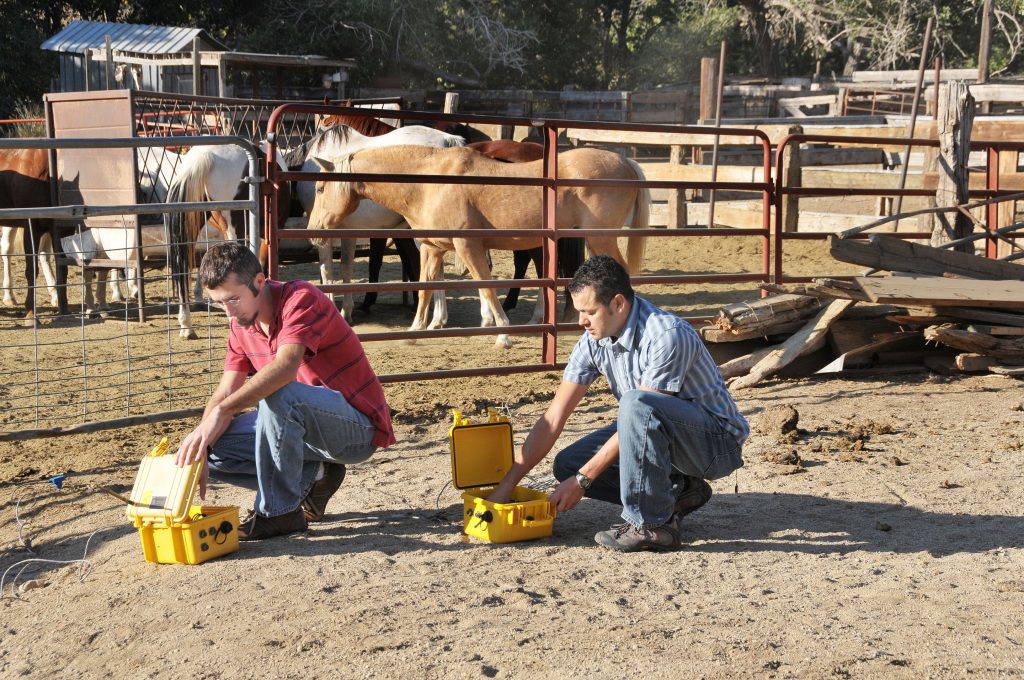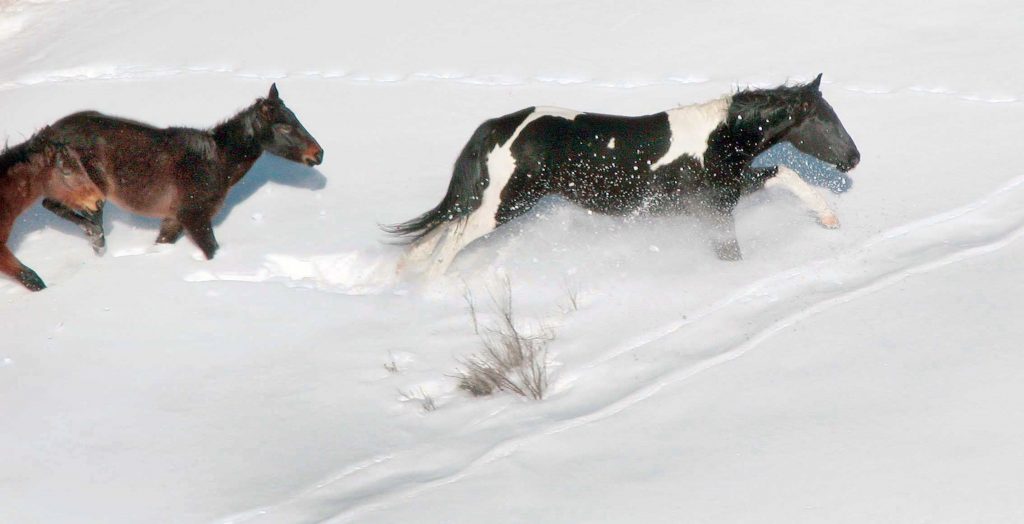
ALBUQUERQUE, N.M. —Sensor technology developed at Sandia National Laboratories for national security purposes may soon play a role in saving wild horses.
Two Labs researchers, Casey Giron and Josh Jacob, are working with National Forest Service rangers in the Jicarilla Wild Horse Territory to come up with ways to better detect the location of the animals in order to trap and relocate them. The territory falls in an area of the Carson National Forest in northern New Mexico located near the Colorado border.
“The wild horses are overpopulating this territory far above the appropriate management level,” says Anthony Madrid, wild horse and burro coordinator and ranger for the Carson National Forest. “Mt. Taylor Mustangs [Forest Service gather contractor] asked Sandia to help with a sensor technology that will make it easier to know when the horses are in a trapping corral.”
The request came through the New Mexico Small Business Assistance Program — the Labs-run program that allows Sandia to apply a portion of the gross receipts taxes it pays each year to provide technical advice and assistance to New Mexico small businesses.
More than 425 wild horses roam the Jicarilla Wild Horse Territory, an area Forest Service officials determined in an assessment four years ago could only accommodate between 50 and 105 of the animals. Grass and foliage that serve as feed for the horses and other wild animals are running thin, say Forest Service officials, and concerns exist that there may not be adequate grazing areas. Right now, the horses appear healthy, but that could change if food sources disappear.
The Bureau of Land Management and National Forest Service routinely round up wild horses in overpopulated areas, relocate them to central holding areas, and attempt to adopt them out. This fall the Carson National Forest initiated a wild horse gather program and plans to gather 93 horses. Horses from the Jicarilla territory go to Farmington, where they are put up for adoption.
Horse roundup is a tedious process. Once horses are known to be in a certain area, a corral is built, and bait — salt and minerals — is set out. Later, hay is added as a further enticement. The trapper, a contractor with Mt. Taylor Mustangs, then sits in wait inside a trailer located 50 to 100 yards away from the corral. A video camera connected to a monitor in the trailer tracks horse visitors. When the trapper sees the horses inside the pen on the monitor, he pushes a button to remotely close the gate.
The downfall with this method, says Madrid, is that sometimes the horses sense the human. This makes them shy away from the corral.
It became Giron and Jacob’s job to come up with a way the trapper can be in a camp several miles away from the corral, still be able to watch the horses, and then remotely close the gate.
“We knew the system had to be cost effective. Otherwise the National Forest Service could not afford to deploy it,” Giron says. “We knew that developing a new sensor system from the ground up would cost way too much. So we decided to adapt something already developed here at Sandia or modify an off-the-shelf product.”
The two researchers had working experience with a system designed a couple of years ago at Sandia for national security purposes. About the size of a shoebox, the waterproof plastic containers each hold a radio transmitter, electronics processor, and externally connected seismic sensors. They are also adding the capability for a thermo-imaging video camera. A photovoltaic solar panel would charge the batteries, making the unit self-sufficient.

The system is designed for the seismic sensors to detect when an animal the size of a horse is in the vicinity. Once alerted by the sensors to the animal, the camera turns on and sends an image via the radio transmitter to the trapper who might be in a small camper as far as five miles away. The trapper would monitor the camera and as soon as he sees several horses in the corral, he would shut the gate from his remote location. Shortly after, he would herd the animals into a horse trailer — a difficult process in itself — and take them to a holding pen.
“What’s really nice about this system is that the trapper can simultaneously monitor multiple sites, which could be separated by miles. Right now the trapper must sit in wait for several days, sometimes weeks, waiting for the right moment to close the gate. The conditions in which they wait can be quite extreme because they cannot use any heat, air-conditioning, or anything that would alert the animals to their presence. Allowing the trapper to move to a remote location relieves the stress from both the trapper and the horses.” Giron says.
As a second option, Giron and Jacob are also looking at modifying commercially available off-the-shelf systems. They are finalizing their recommendations and should deliver them to the National Forest Service soon.
“We anticipate the technology Sandia will recommend will be a huge help to us,” Madrid says. “Having the ability to monitor multiple traps at the same time will make our work much more efficient and productive.”
Carson National Forest has horses available for adoption. People interested in adopting a wild horse can call (505) 632-2956 or go online at http://www.fs.fed.us/r3/carson.



